|
|
|
Sort Order |
|
|
|
Items / Page
|
|
|
|
|
|
|
| Srl | Item |
| 1 |
ID:
173133
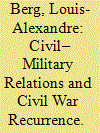

|
|
|
|
|
| Summary/Abstract |
Does restructuring security forces reduce the risk of civil war recurrence? Prior research has examined effects of military integration in alleviating commitment problems, but the evidence has been inconclusive. Other aspects of civil–military relations have received less attention. This article examines the effects of civil–military relations in the context of postwar struggles to consolidate authority. It outlines three pathways through which security forces contribute to renewed civil war: by excluding rival factions and facilitating insurgent mobilization, by exploiting control over resources to challenge the regime, or by escalating incipient insurgency through repression. Analysis of original, cross-national data on postwar civil–military relations shows that reducing the potential for exclusion and exploitation through diverse officer appointments and robust civilian oversight lowers the risk of civil war. These findings emphasize the distributive effects of restructuring security forces and highlight the value of examining political contests around state institutions to understand why civil wars restart.
|
|
|
|
|
|
|
|
|
|
|
|
|
|
|
|
| 2 |
ID:
157363


|
|
|
|
|
| Summary/Abstract |
Why do some postconflict states return to violence, while others remain at peace? Analysts increasingly credit postconflict justice institutions—such as truth commissions, amnesties, reparations, and trials—with contributing to the prevention of conflict recurrence following civil wars. But scholars remain divided about the overall effectiveness of these varied institutions. In this article, we directly engage this debate. We seek to overcome theoretical and data limitations that make it difficult to address the relationship between justice institutions and the likelihood that conflict will recur. We find that only postconflict justice processes that lessen conflict-induced grievances, and thus address individual motivations to rebel, are successful at keeping the peace. In a series of statistical tests using new data on postconflict justice from 1946 to 2006, we find strong support for the role of motivation-addressing processes in reducing conflict recurrence.
|
|
|
|
|
|
|
|
|
|
|
|
|
|
|
|
| 3 |
ID:
086000
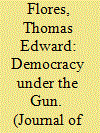

|
|
|
|
|
| Publication |
2009.
|
| Summary/Abstract |
Increasingly, scholars studying civil conflicts believe that the pace of postconflict economic recovery is crucial to a return to peaceful politics. But why do some countries' economies recover more quickly than others'? The authors argue that the inability of politicians to commit credibly to postconflict peace inhibits investment and, hence, slows recovery. In turn, the ability of political actors to eschew further violence credibly depends on postconflict political institutions. The authors test this framework with duration analysis of an original data set of economic recovery, with two key results. First, they find that postconflict democratization retards recovery. Second, outright military victory sets the stage for a longer peace than negotiated settlements do. This research deepens the understanding of the bases of economic recovery and conflict recidivism in postconflict countries and points to future research that can augment this knowledge further still.
|
|
|
|
|
|
|
|
|
|
|
|
|
|
|
|
| 4 |
ID:
152301
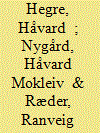

|
|
|
|
|
| Summary/Abstract |
Several studies show that internal armed conflict breeds conflict by exacerbating conditions that increase the chances of war breaking out again. Empirically, this ‘conflict trap’ works through four pathways: conflicts increase the likelihood of continuation, recurrence, escalation, and diffusion of conflict. Past empirical studies have underestimated the scope and intensity of the conflict trap since they consider the impact of conflict only through one of these pathways and rarely across sufficiently long time periods. This article shows that simulation and forecasting techniques are useful and indeed necessary to quantify the total, aggregated effect of the conflict trap, over long time periods and across countries. We develop a country-year statistical model that allows estimating the probability of no conflict, minor conflict, and major conflict, and the probabilities of transition between these states. A set of variables denoting the immediate and more distant conflict history of the country are used as endogenous predictors in the simulated forecasts. Another set of variables shown to be robustly associated with armed conflict are treated as exogenous predictors. We show that the conflict trap is even more severe than earlier studies have indicated. For instance, if a large low-income country with no previous conflicts is simulated to have two to three years of conflict over the 2015–18 period, we find that it will have nine more years of conflict over the 2019–40 period than if peace holds up to 2018. Conversely, if a large low-income country that has had major conflict with more than 1,000 battle-related deaths in several of the past ten years succeeds in containing violence to minor conflict over the 2015–18 period, we find that it will experience five fewer years of conflict in the subsequent 20 years than if violence continues unabated.
|
|
|
|
|
|
|
|
|
|
|
|
|
|
|
|
| 5 |
ID:
141188
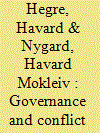

|
|
|
|
|
| Summary/Abstract |
Many conflict studies regard formal democratic institutions as states’ most important vehicle to reduce deprivation-motivated armed conflict against their governments. We argue that the wider concept of good governance—the extent to which policy making and implementation benefit the population at large—is better suited to analyze deprivation-based conflict. The article shows that the risk of conflict in countries characterized by good governance drops rapidly after a conflict has ended or after independence. In countries with poor governance, this process takes much longer. Hence, improving governance is important to reduce the incidence of conflict. We also decompose the effect of good governance into what can be explained by formal democratic institutions and less formal aspects of governance, and into what comes from economic development and what is due to how well countries are governed. We find that informal aspects of good governance to be at least as important as formal institutions in preventing conflict and that good governance has a clear effect over and beyond economic development.
|
|
|
|
|
|
|
|
|
|
|
|
|
|
|
|
| 6 |
ID:
154845
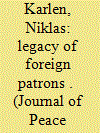

|
|
|
|
|
| Summary/Abstract |
Why do some armed conflicts that have ended experience renewed fighting while others do not? Previous research on conflict recurrence has approached this question by looking at domestic factors such as how the war was fought, how it ended or factors associated with its aftermath. With the exception of the literature on third-party security guarantees, the influence of outside actors has often been overlooked. This article explores the role of external states and suggests when and how their involvement is likely to affect the probability of renewed warfare. The main argument is that the legacy of outside support creates an external support structure that affects the previous combatants’ willingness as well as their opportunities to remobilize. This means that armed conflicts with external state support will experience a greater likelihood of recurrence compared to other conflicts which did not see external support. The theory is tested using Cox proportional hazards models on global data of intrastate armed conflicts 1975–2009. The findings suggest that external support to rebels increases the risk of conflict recurrence in the short term as groups receive or anticipate renewed assistance. The results also indicate that it is more important for rebel groups to have had enduring support over the years in the previous conflict rather than access to multiple state sponsors. External support provided to governments is not associated with conflict recurrence.
|
|
|
|
|
|
|
|
|
|
|
|
|
|
|
|
| 7 |
ID:
158217
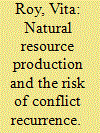

|
|
|
|
|
| Summary/Abstract |
Do different types of natural resources have varying impacts on the risk of conflict recurrence? Using a classification of high-value natural resources according to their lootability and obstructability, this article develops a framework bridging research on natural resources and conflict recurrence. I find evidence for the destabilizing character of easily lootable resources that is coherent across different conflict data. Non-lootable resources show little robust effects at first sight; but when introducing a measure of obstructability, the analysis uncovers varying effects of obstructable and non-obstructable resources that interact with the mode of conflict termination. Overall, the results underline the importance of attending to the lootability and obstructability dimension of natural resources when researching post-conflict risks in resource endowed states.
|
|
|
|
|
|
|
|
|
|
|
|
|
|
|
|
| 8 |
ID:
171971
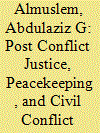

|
|
|
|
|
| Summary/Abstract |
This article studies how when post-conflict justice works alongside a peacekeeping operation following a civil conflict, a two-pronged pacifying effect is activated. While justice mechanisms deal with the factors underlying the conflict, peacekeepers increase the costs for the potential spoilers of the peace while also supporting the justice processes. The findings in this study have important implications for conflict-ridden states attempting to escape the ‘conflict trap’.
|
|
|
|
|
|
|
|
|
|
|
|
|
|
|
|
| 9 |
ID:
117017
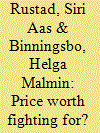

|
|
|
|
|
| Publication |
2012.
|
| Summary/Abstract |
While a number of publications show that natural resources are associated with internal armed conflict, surprisingly little research looks at how natural resources affect post-conflict peace. This article therefore investigates the relationship between natural resources and post-conflict peace by analyzing new data on natural resource conflicts. We argue that the effect of natural resources on peace depends on how a country's natural resources can constitute a motive or opportunity for armed conflict. In particular, three mechanisms may link natural resources to conflict recurrence: disagreements over natural resource distribution may motivate rebellion; using natural resources as a funding source creates an opportunity for conflict; and natural resources may aggravate existing conflict, acting either as motivation or opportunity for rebellion, but through other mechanisms than distributional claims or funding. Our data code all internal armed conflicts between 1946 and 2006 according to the presence of these resource-conflict links. We claim such mechanisms increase the risk of conflict recurrence because access to natural resources is an especially valuable prize worth fighting for. We test our hypotheses using a piecewise exponential survival model and find that, bivariately, armed conflicts with any of these resource-conflict mechanisms are more likely to resume than non-resource conflicts. A multivariate analysis distinguishing between the three mechanisms reveals that this relationship is significant only for conflicts motivated by natural resource distribution issues. These findings are important for researchers and policymakers interested in overcoming the 'curse' associated with natural resources and suggest that the way forward lies in natural resource management policies carefully designed to address the specific resource-conflict links.
|
|
|
|
|
|
|
|
|
|
|
|
|
|
|
|
| 10 |
ID:
165452
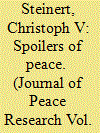

|
|
|
|
|
| Summary/Abstract |
This study investigates how deployment of pro-government militias (PGMs) as counterinsurgents affects the risk of conflict recurrence. Militiamen derive material and non-material benefits from fighting in armed conflicts. Since these will likely have diminished after the conflict’s termination, militiamen develop a strong incentive to spoil post-conflict peace. Members of pro-government militias are particularly disadvantaged in post-conflict contexts compared to their role in the government’s counterinsurgency campaign. First, PGMs are usually not present in peace negotiations between rebels and governments. This reduces their commitment to peace agreements. Second, disarmament and reintegration programs tend to exclude PGMs, which lowers their expected and real benefits from peace. Third, PGMs might lose their advantage of pursuing personal interests while being protected by the government, as they become less essential during peacetimes. To empirically test whether conflicts with PGMs as counterinsurgents are more likely to break out again, we identify PGM counterinsurgent activities in conflict episodes between 1981 and 2007. We code whether the same PGM was active in a subsequent conflict between the same actors. Controlling for conflict types, which is associated with both the likelihood of deploying PGMs and the risk of conflict recurrence, we investigate our claims with propensity score matching, statistical simulation, and logistic regression models. The results support our expectation that conflicts in which pro-government militias were used as counterinsurgents are more likely to recur. Our study contributes to an improved understanding of the long-term consequences of employing PGMs as counterinsurgents and highlights the importance of considering non-state actors when crafting peace and evaluating the risk of renewed violence.
|
|
|
|
|
|
|
|
|
|
|
|
|
|
|
|
|
|
|
|
|